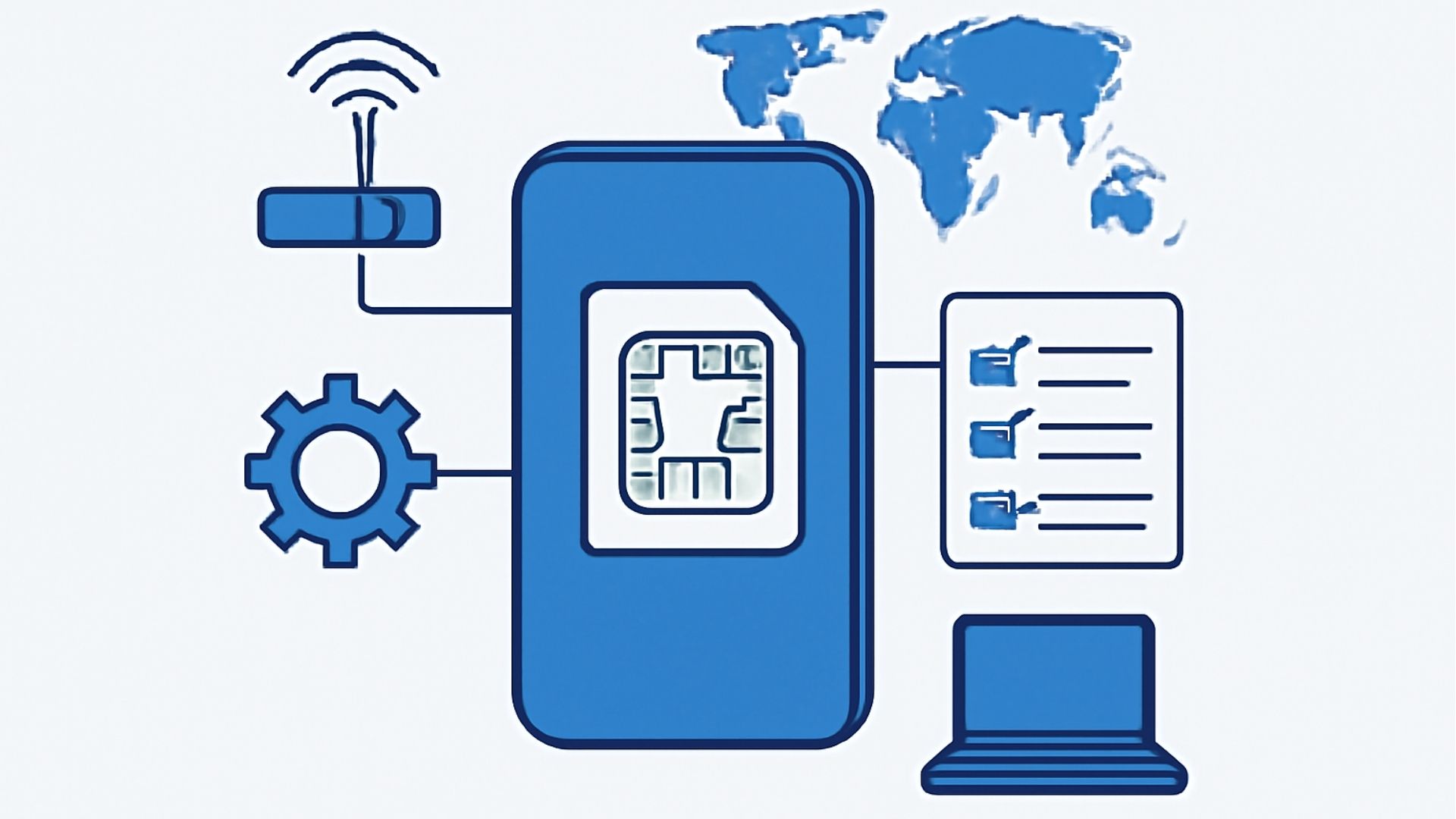Checklist: What to Look for in a Business eSIM Provider
Choosing the right business eSIM provider ensures seamless global connectivity, strong security, and efficient cost management. This complete checklist helps businesses evaluate every critical factor, from coverage and pricing to support and compliance.

In today’s interconnected world, consistent connectivity is not just a convenience, it is a business necessity. Whether you manage global teams, deploy IoT devices, or operate across multiple regions, reliable mobile data connectivity is essential.
eSIM technology has become a game changer for enterprises by replacing physical SIM cards with digital profiles that can be activated instantly across devices. Yet, not all eSIM providers are equal. The wrong choice can lead to service gaps, high costs, or poor management capabilities.
This guide presents a complete checklist for evaluating a business eSIM provider, ensuring your organization selects one that supports scalability, security, cost efficiency, and performance.
Why Business eSIMs Require Special Consideration
Business requirements differ greatly from consumer or travel-based eSIM use cases. Companies operate at scale with global teams, diverse devices, and strict compliance standards. Here’s why your selection criteria must be more detailed:
- Scale and control: Businesses need centralized dashboards, user management, usage analytics, and automation tools.
- Coverage and quality: Connectivity must remain strong across cities, borders, and remote areas.
- Security and compliance: Data protection, encryption, and adherence to regional laws such as GDPR are essential.
- Flexibility and cost management: Enterprises must control budgets and prevent billing surprises.
- Future readiness: Providers must evolve with emerging technologies like 5G, private networks, and IoT integrations.
Comprehensive Checklist for Selecting a Business eSIM Provider
Network Coverage and Quality
a. Geographic Reach
- Verify that the provider covers all countries or regions where your teams operate.
- Check for reliable service beyond major cities. Rural coverage matters for logistics and field teams.
- Ensure consistent performance across borders and secondary markets where you may expand.
b. Network Generations and Technology
- Confirm support for 4G, LTE, and 5G networks.
- For IoT use cases, check for NB IoT or LTE M compatibility.
- Assess latency, data speed, and signal stability across all target locations.
c. Service Level and Reliability
- Choose a provider offering clear Service Level Agreements (SLAs) for uptime, latency, and data loss.
- Ask about redundancy or fallback routes during outages.
- Ensure smooth roaming and automatic connection to local partner networks.
d. Device Compatibility
- Confirm that eSIM profiles work across your smartphones, tablets, laptops, and IoT devices.
- Validate dual SIM functionality for users who maintain local lines alongside business connectivity.
- Check for restrictions on tethering or data sharing if your teams use hotspots frequently.
Why it matters:
Without reliable coverage and consistent performance, business connectivity breaks down, impacting operations, customer experience, and productivity.
Provisioning, Activation, and Management
a. Easy Activation
- Look for instant provisioning via QR code, mobile app, or zero touch onboarding through your MDM system.
- Ensure that eSIMs can be remotely activated and reassigned.
b. Centralized Dashboard
- A unified admin portal should allow you to view all active devices, manage plans, monitor usage, and set alerts.
- Seek role based access control so regional managers can manage their own teams independently.
c. API Integration and Automation
- Enterprise operations often require automation. Choose a provider with robust APIs for activation, deactivation, billing data, and alerts.
- Bulk operations like provisioning hundreds of devices should be supported.
d. Lifecycle Management
- The provider should let you suspend, reassign, or delete eSIMs remotely.
- Enable data caps or automatic restrictions when usage exceeds thresholds.
- Look for device grouping and usage analytics for better tracking.
Why it matters:
Manual provisioning leads to inefficiency. Centralized and automated management supports scale and saves administrative time.
Pricing Structure and Plan Flexibility
a. Plan Options
- Evaluate whether the provider offers data only, voice and data, or hybrid plans.
- Check for regional, global, or pooled data packages.
- Confirm if unlimited or shared data plans are available for teams.
b. Pricing Transparency
- Choose a provider with clear and predictable pricing.
- Avoid hidden fees for activation, roaming, or device swaps.
- Ensure you can set usage limits or receive alerts to prevent overages.
c. Enterprise Discounts
- Verify volume based pricing for bulk eSIM purchases.
- Check if the provider offers shared data pools across regions or departments.
- Look for flexible contract terms that adapt to your business growth.
d. Contract and Cancellation Terms
- Review contract length whether monthly, annual, or pay as you go.
- Understand deactivation policies and data rollover availability.
Why it matters:
Unclear pricing or hidden costs can inflate expenses. Transparent and flexible plans simplify budgeting and control.
Support, SLA, and Relationship Management
a. 24×7 Support Availability
- Business operations demand round the clock assistance via chat, phone, or email.
- Dedicated account managers or enterprise support channels are ideal.
b. Service Level Agreement (SLA)
- Choose a provider that guarantees uptime and response time, with compensation for service breaches.
- Review escalation procedures for critical incidents.
c. Contract Terms
- Ensure fair exit conditions and minimal penalties.
- The provider should have proven stability and reliability.
d. Vendor Evolution
- Ask about the provider’s roadmap and support for future technologies like 5G standalone or private LTE networks.
Why it matters:
Enterprise grade support ensures fast problem resolution and predictable service quality. Weak support can cause costly downtime.
Security, Privacy, and Compliance
a. Data Security
- Verify encryption of data in transit and at rest.
- Administrative portals should include multi factor authentication and detailed audit logs.
- Ask about internal access control and data storage policies.
b. Compliance
- Confirm adherence to GDPR, CCPA, and other local data protection laws.
- Ensure data handling complies with jurisdictional requirements.
- Evaluate breach response policies and transparency.
c. Fraud Protection
- The provider should have mechanisms to prevent SIM swap fraud and unauthorized access.
- Look for real time alerts for anomalies like high data usage or device changes.
d. Transparency
- The provider should disclose all network partners, routing policies, and backup infrastructure.
Why it matters:
Security and compliance are non negotiable for business connectivity. A secure provider protects both data and brand reputation.
Integration, Scalability, and Future Readiness
a. Multi Region Flexibility
- Choose providers with global coverage and consistent management tools.
- Ensure the ability to share or pool data among devices worldwide.
b. API and Workflow Integration
- Integration with CRM, ERP, billing, or IoT systems simplifies management.
- White label or custom workflow options help service providers and large enterprises.
c. Scalability
- The provider should support growth from dozens to thousands of devices without disruptions.
- Look for readiness for future technologies such as private LTE, IoT narrowband, and advanced 5G.
d. Avoiding Lock In
- Ensure your business retains ownership of data and can migrate profiles or export reports easily.
Why it matters:
A scalable and future ready provider ensures your investment remains valuable as your operations evolve.
Use Case Based Evaluation
a. Remote Workforce
- Focus on global data coverage, hotspot support, and flexible plan durations.
- Dual SIM capability helps employees stay reachable on both personal and work lines.
b. IoT Deployments
- Look for long term plans and remote provisioning for devices in the field.
- Ensure automation and device grouping for large deployments.
c. Global Enterprises
- Choose a provider offering global pooling, unified billing, and regional dashboards.
- Regulatory compliance across jurisdictions is essential.
d. Backup Connectivity
- For retail or branch operations, ensure automatic failover and alerts for outages.
Why it matters:
Every business scenario requires specific priorities. Tailoring your checklist by use case ensures a perfect operational fit.
Practical Questions to Ask Before Signing a Contract
- Which networks do your eSIMs connect to in our key countries?
- What average speed and latency can we expect?
- Can you share SLA metrics or business client references?
- How quickly can we activate or deactivate large batches of eSIMs?
- Can your platform integrate with our CRM, ERP, or MDM systems?
- What is your response time during off hours?
- Are there additional fees for roaming or data overuse?
- What certifications or audits do you hold?
- How flexible are your contracts for scaling up or down?
- What is your roadmap for future network advancements?
Ranking Features by Business Priority
| Priority | Key Features |
|---|---|
| High | Reliable coverage, transparent pricing, strong security, 24×7 support, centralized dashboard, SLA commitment |
| Medium | API automation, pooled data, IoT compatibility, regional billing |
| Low | Voice or SMS add-ons, short term plans, consumer features |
Key Insight: Focus first on coverage, cost visibility, management control, and security before considering secondary features.
Common Mistakes to Avoid
- Selecting purely on cost: Cheap plans often compromise reliability and support.
- Ignoring management tools: Without a strong portal, scaling operations becomes difficult.
- Overlooking SLA and contract terms: Vague terms can lead to disputes later.
- Skipping a pilot program: Always test before large scale rollout.
- Neglecting future needs: Choose a provider that evolves with your business.
Implementation Process
- Define Requirements: Outline geography, device types, and usage patterns.
- Shortlist Providers: Compare coverage, pricing, and SLA terms using this checklist.
- Run a Pilot: Test performance, activation speed, and support quality.
- Negotiate Contracts: Ensure clarity on costs, compliance, and exit rights.
- Deploy and Monitor: Use analytics and alerts to track performance.
- Review Regularly: Reassess provider efficiency every six to twelve months.
Summary and Final Recommendations
Selecting the right business eSIM provider requires strategic evaluation across coverage, management, pricing, support, and security. A strong provider delivers reliable global connectivity and flexibility for future expansion.
Final Takeaways:
- Prioritize reliability and transparency over low pricing.
- Ensure centralized control for easier administration.
- Validate compliance and strong data security.
- Demand SLAs and responsive support.
- Choose a future ready provider with scalable solutions.
A well chosen eSIM partner will help your teams stay connected globally, reduce administrative burden, and enhance overall efficiency.
FAQs
Q1. Are eSIMs secure for business use?
Yes. Business eSIMs use encrypted provisioning and secure authentication, offering strong protection when managed through enterprise platforms.
Q2. Can eSIMs work across multiple countries?
Yes, most business eSIMs include regional or global plans. Always verify network partners and performance before deployment.
Q3. How quickly can a business activate new devices?
Activation can happen instantly via QR code, app, or API integration, making it ideal for onboarding remote employees.
Q4. Are business eSIMs cost effective?
They reduce logistics, roaming charges, and manual management, often lowering total ownership cost over time.
Q5. What if a device is lost?
Administrators can immediately suspend or delete the eSIM profile to prevent unauthorized use.
Q6. How can we ensure compliance with regional laws?
Select providers who comply with international data standards and operate within local telecom regulations.

Seamless eSIM Connectivity for Enterprises
Activate, manage, and scale eSIMs with ease.



 9 min read
9 min read





